
27 Sep Calm your excitable dog down!
Lots of my clients pass off their dogs hyperactivity in the home with ‘oh but he’s from working lines’, ‘it’s a high energy breed’ or ‘she’s only a year old’. All of these reasons are perfectly valid for explaining why your dog has higher energy levels than others, but do not justify the inability to switch off and relax in the home. This means being able to ask your dog to go and lie down calmly for an hour or so during the day- a task that sounds unachievable and daunting to most owners of high energy dogs!
This is not to say that certain breeds won’t be easier to train to relax, for example mountain dogs, basset hounds, greyhounds, mastiffs etc. These breeds naturally tend to spend a lot of their time resting and will require little to no prompting to settle down when they are not being engaged with. Similarly dogs that have passed through adolescence tend to follow this same pattern with increasing levels of lethargy through their lifetime. Unfortunately, for most of us, there is just not enough time in the day when our dogs go to relax!
Now most places you go to find out how to calm a high energy dog will suggest arousing activities such as exercise, play dates, day-care and games to ‘tire the dog out’, however the solution I have found is in fact quite the opposite. Of course it’s important to adequately exercise your dog, both physically and mentally, but the majority of my clients are doing this yet still struggle. This is where behavioural modification techniques come in.
The good news is that calmness through the day is a fairly easy behavioural pattern to hard-wire into our pets, and one that will benefit both us and them.
The first step to this process is simply to reinforce the behaviour whenever you see it. In practice, this means very calmly walking over and placing a treat on the ground near the dog whenever they are relaxed, lying down, non-aroused. You can do this same procedure using praise and calm affection if your dog gets too excitable around food. This teaches the dog that food and praise is not always paired with excitement, and that calm behaviour is reinforcing.
On the opposite side of this spectrum, we can negatively punish the excitable behaviour that we don’t want through completely ignoring the dog when it preforms this behaviour. This means do not talk, touch or even look at your dog. You will often see older dogs and mothers doing this to puppies when they get too excitable by turning there heads and looking away- they may even close their eyes! An example of this practice that you can incorporate in every day is when coming through the door. Of course its lovely that your dogs excited to see you, but if youre dealing with hyperactivity in the home do not acknowledge this excitement and instead wait for calm before you greet.
Another great technique that can help to stop this behaviour from happening in the first place is to put a lead on the dog. I often will instruct my clients to do this at the time when the dog usually becomes most excitable (often the evening zoomies!) Use the lead to take the dog out of the room for a few minutes when he\she starts to become too aroused. Praise as the dog becomes calm again and reintroduce them to the room. This prevents the behaviour from escalating and allows you to reinforce good behaviour as opposed to being forced into correcting the bad. You can also do this at times where there is a predictable pattern of over excited behaviour- such as when people come to visit.
A great game you can play with your dog to build up their self control in situations they find arousing is what I call the ‘Look Away’ game. Here you get your dog involved in a really great game of tug, fetch or even just throwing them pieces of food. When the dog is excited and engaged in the game you then hold the object of interest (toy or food) out to the side of your body and wait. The dog will initially stare at the object and not know what to do. Some dogs will then look to you and you mark this with the cue ‘Look At Me’ then release the object as reinforcement. Repeat this over and over again!
Eventually the aim is to be mid play and at your dogs most excitable point and be able to ask for ‘Look At Me’ to pause the game and get focus back onto you. This game teaches a great degree of self control.
Do you have a hyperactive dog? Try these techniques and with some patience and consistency bring calm back into your life!


Sorry, the comment form is closed at this time.